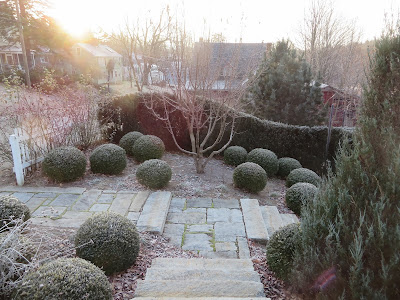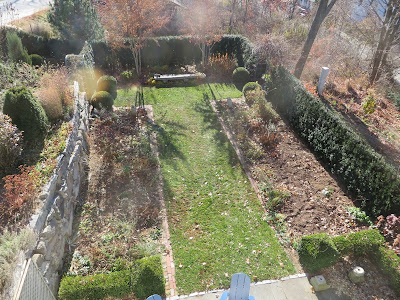The gardener's eye
The Gardener's Eye
Wednesday, December 4, 2013
Sunday, November 17, 2013
Groundcovers Die
July 2011
November 2013
I was getting awfully proud of my planting of native Pachysandra procumbens (Allegheny spurge) in the Hall with Balls. I had gotten my original plants from Charles Cresson's Swarthmore garden over a decade ago. Year after year, I divided the plant until it created a carpet underplanting the boxwood rounds in the Hall with Balls. Just as the carpet had nearly filled in, it began to falter and gradually, then more rapidly, it disappeared. This summer it was entirely gone.
My post-mortem evaluation revealed vole activity, but more importantly, mushy roots. I knew this part of the garden was too sunny for Pachysandra procumbens but I thought as the enclosing yew hedges grew and the central Cornus officinalis matured, the garden would become progressively more shady making the Pachysandra procumbens increasingly more happy. My hypothesis is that the pachysandra had succumbed to Volutella blight, caused by the fungus Volutella pachysandricola, because it was stressed from being in too hot and dry of a situation. I will watching this part of the garden carefully because pachysandra may also be a host for boxwood blight and the Cylindrocladium pseudonaviculatum fungus. Apparently, plant species within the genera Buxus, Pachysandra and Sarcococca have been reported as hosts to this fungus. Fortunately the boxwoods appear to be healthy so far.
I have replaced the pachysandra with Carex flacca 'Blue Zinger', a sedge from Europe and North Africa which has fine narrow glaucous leaves. The whispy texure of 'Blue Zinger' will contrast well against the dark green foliage of the boxwoods in the Hall with Balls and should form a clumping groundcover in about five years.
Hedges Grow
November 2000
November 2013
The yew hedge enclosing the Lower Garden was planted 13 years ago. I spent a couple years terracing the land wheelbarrow load by wheelbarrow load. That phase was not a pretty site; it looked more like a construction site than a garden. I spent most of my budget on loam so when it came time to plant the hedge, I used tiny bareroot whips of Hick's yew, Taxus × media 'Hicksii'. I remember reading in The Vita Sachville-West's Garden Book that small plants establish more quickly and caught up in height with larger plants in a few years. Since I couldn't afford large plants, I liked that idea a lot. The hedge was a bit of a joke with gardening friends for about 7 years and then miraculously, it became a wall which created a garden room. Visually and emotionally, it made the visitor feel like they would not tumble down the steep slope on which the garden has been built. What is planted in the garden beds continues to evolve but the structure or bones will hopefully survive for many years to come.
Thursday, November 14, 2013
Boccelli Garden: The Public/Private Partnership
The Boccelli Garden is located on a small triangular plot along the Nubanusit River on Grove Street. Across the river, an old building is being beautifully renovated into a multi-use facility. There will be retail space, a bakery, condominiums and office space. The owners wanted to enhance their view of Boccelli Garden from their property and offered to partner with the town to make improvements including replacing a chain-link fence, cleaning out brush obscuring views into the river, building a retaining wall and new shrub garden and adding a bluestone patio adjacent to the Boccelli Garden.
There was a house and barn once owned by the Boccelli family in the first half of the 1900's where the garden is now located. I believe theses steps once joined the driveway to the barn. I have always admired them. Maude Odgers, a Parks Committee member and volunteer gardener, suggested that we put a patio and seating area in this spot.
Below the patio, a shrub garden was planned here.
This is a view from the Boccelli Garden to the property across the river. There is an unattractive chain-link fence along the river. Volunteer trees have obscured the view of the Nubanusit River.
This was the view of the Boccelli Garden from across the river.
Large equipment was required for the job.
The abutter donated granite to be used to make a retaining wall to form a terrace for the new patio.
All the scrub trees were removed along the river when the fence was dismantled. This is the view from the bridge on Grove Street. The ancient apple tree, planted by Michael Boccelli nearly 100 years ago, is nowa central feature to the park. Later in the season, tree work will be done to limb it up to enhance views from every direction.
Temporary Safety fencing was installed.
Excavation work was done near the stairs. The granite bench was relocated to the edge of the Nubanusit River.
The new retaining wall in progress.
A look from the street.
The new fence as seen from across the river.
The sand base layer to the bluestone patio.
The view of the apple tree from the patio. Note the granite bench was relocated by the river's edge in the middle of the photograph.
The fence looks handsome and the Boccelli Garden is now visible from across the river.
This is the same view from the other side of the river as the fifth photograph.
From the bridge: the retaining wall, the Boccelli Garden and Michael Boccelli's apple tree.
We have been extremely fortunate to have repeated pattern of private underwriting like this in our public spaces here in Peterborough. Private donations, grants and public investment feed off one another to create unique and beautiful public spaces and the volunteers work diligently to keep them maintained at the highest level possible.
Sunday, October 20, 2013
Dixter Comes to Peterborough
Gardening buddy and author of Anemone Times, Heleln O'Donnell, called with a couple of hours notice to say she and two gardening friends from her days at Great Dixter would like to visit my garden. They were having coffee downtown and had admired the Pavilion Garden (my last post) at Depot Park and Helen thought they might like to see my private garden. Helen has done two stints as a garden student at Great Dixter. Her friend Yannick Boulet is currently a gardener at Great Dixter and Emma Seniuka is a recent Dixter alumni now working at Chanticleer as the Head Gardener in the Cut-flower and Vegetable Garden. I hadn't lifted a finger in the garden for weeks, so I warned them that the garden wasn't quite ready for prime time and invited them over.
Fellow blogger and Dixter Student, Helen O'Donnell, Section Gardener at Chanticleer, Emma Seniuk, and Dixter Gardener for 3 years running, Yannick Boulet in my Upper Garden.
Everyone wanted me to identify the grass in the upper garden: Calamagrostis brachytricha, seen here deep in the garden with Aster 'Little Carlow', Hibiscus acetosella 'Maple Sugar' and Ligustrum sinensis 'Variegata', Salvia 'Indigo Spires' and Mina lobata and Cuphea 'Bat Face'
Rubus thibetanus was another plant they all knew and liked. I am planning to save a division for Helen's VT garden.
Acer triflorum foliage burned bright orange and formed a backdrop to the Upper Garden and The Hall With Balls.
Cobaea scandens was still in bloom covering the arch dividing The Hall With Balls and the Lower Garden.
I got to show them my brand new planting on the slope in the Woodland Garden. It was quite sparse but the colors gave a suggestion of the show that hopefully be a pretty picture in a few years: Rhus coppalina, Callicarpa bodinieri 'Profusion', Hydrangea quercifolia 'Snowqueen', Rhus aromatica 'Gro-Low', Vaccinium angustifolium, Arctostaphylos uva-ursi and Lindera glauca var. angustifolia
Disanthus cercidifolius and Helleborus foetidus was a combination I thought looked sensational in the Woodland Garden. Everyone seemed to agree. I had mentioned to Yannick that Christopher Lloyd's book Succession Planting for Year-round Pleasure had given me many ideas for the mixed border in the Upper and Lower Gardens but I forgot to tell Emma how the Asian Woods at Chanticleer have been an indispensable inspiration for the Woodland Garden. I have been very fortunate to have several gardening mentors over the years; some, sadly, are now no longer with us. It was a great pleasure for me to have members of the next generation of great gardeners come to for a visit.
Thursday, October 17, 2013
Depot Park Ready for 'Peak into Peterborough'
Saturday, October 19 is the Greater Peterborough Chamber of Commerce's annual fall foliage tour called 'Peak into Peterborough'. We try to make sure the parks are in tip-top shape for the visitors. Depot Park looked particularly good this week. We haven't had a killing frost so many of the gardens remained lush late into the season.
Miscanthus 'Morning Light' compliments the foliage Fagus sylvatica 'Asplenifolia' aka the Fern Leaf Beech.
A path in the park with several Malus 'Sugar Tyme' in full fruit.
The upright foliage and flowers of Molinia litoralis ‘Windspiel’ with Aster oblongifolius 'October Skies' planted at its feet at the Pavilion Garden.
Pennisetum purpureum 'Vertigo', a new grass we tried this year, was a big success. It hasn't had a long enough season to flower but the strap-like burgundy foliage was enough of a show.
The vertical spires of Eupatorium capillifolium in the Pavilion Garden look particularly lovely in the autumn light.
A close up of Eupatorium capillifolium., a native Joe Pye Weed from the South up to Massachusetts. It can become an invasive pest in warmer gardens but it performs well here as an annual: an outstanding textured punctuation point.
Labels:
Depot Park
Saturday, September 28, 2013
Tuesday, September 24, 2013
Subscribe to:
Comments (Atom)

























































